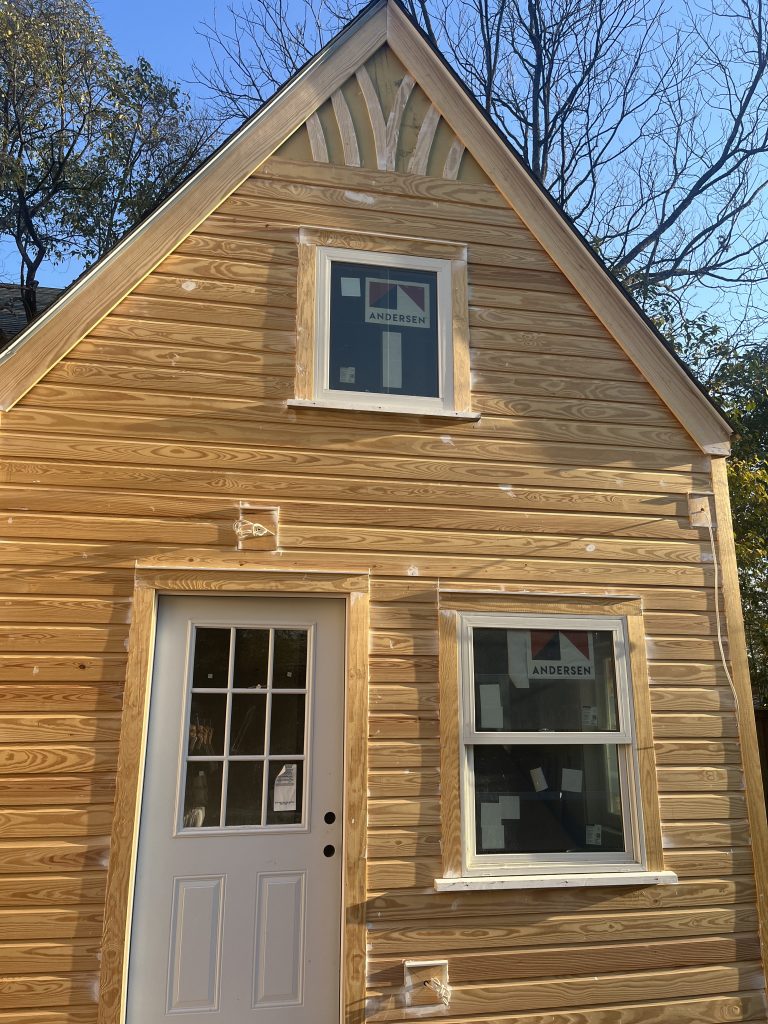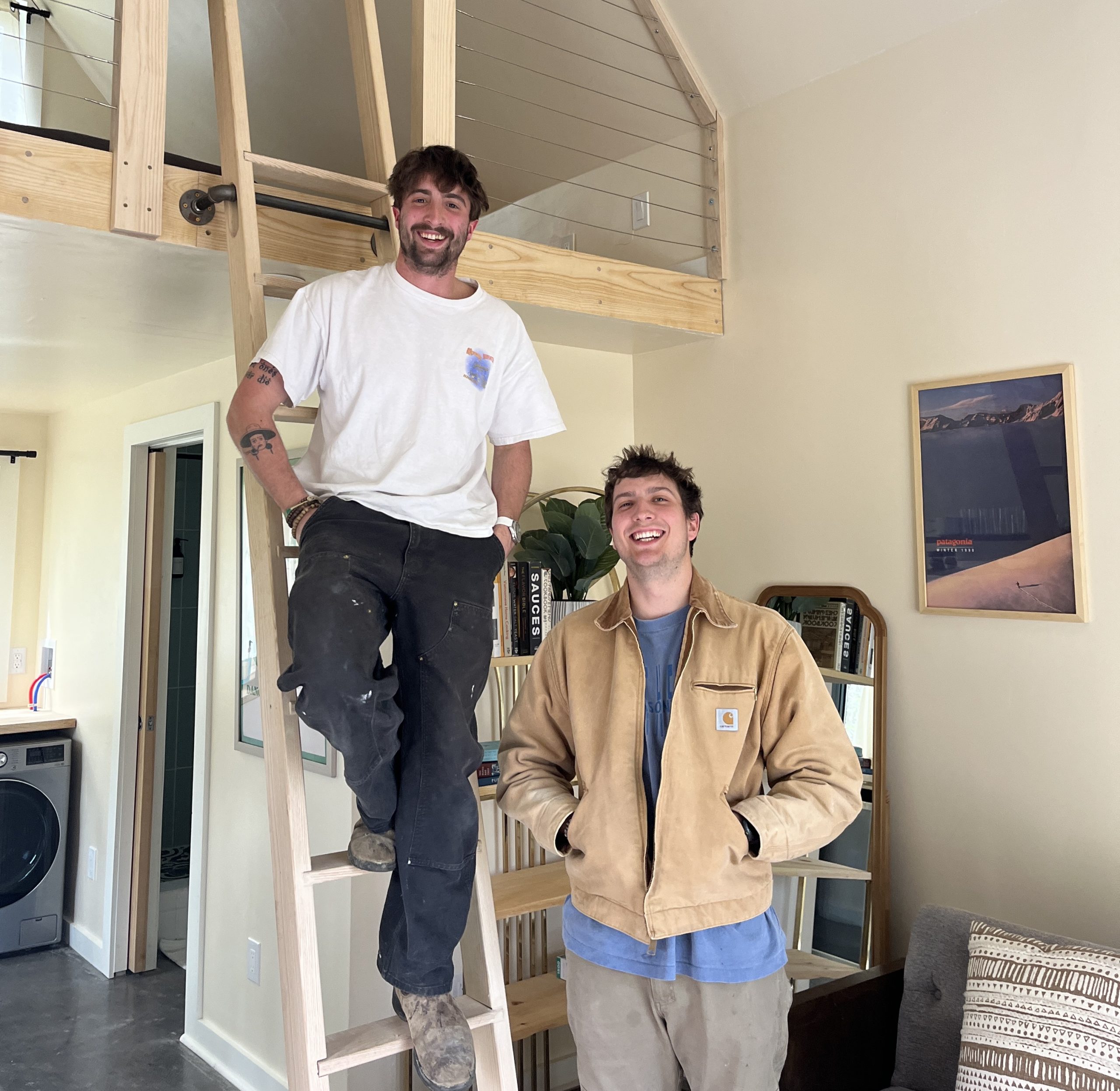To most people passing by Ben and Isaiah Jernigan’s house on Ellis Road, there is nothing remarkable about the sage green outbuilding in their backyard.
Even though the structure looks like it could be a shed, it’s actually the brothers’ “tiny house.” They began building the home last September and have been offering it as a short-term rental on Airbnb since February.
The front door opens directly into the living room, which fits a gray couch and a standing bookcase that holds cookbooks such as “Vietnamese Home Cooking” and “Chez Panisse.”
Even though the home’s floor plan measures just under 300 square feet, the A-frame, with its 17-foot ceilings, feels far from “tiny.”
“That’s why the square models–– we weren’t a fan of,” Isaiah says. “We knew height made it feel like it was a lot bigger.”
The City of Durham calls their tiny house an accessory dwelling unit, or “ADU,” and allows one to be built on any lot with an existing home.
ADUs can be as large as 1,200 square feet in Durham. Tiny homes are loosely defined as houses under 500 square feet, and they represent a fraction of these secondary backyard dwellings.
Still, tiny homes are popping up in backyards across Durham, where they provide housing for relatives or are rented out for short-term stays and to long-term tenants.
Durham currently boasts over a dozen tiny home Airbnbs, and the feedback from guests has been overwhelmingly positive. Ben and Isaiah’s tiny home gets a 4.80-star rating on the platform, while another tiny house in Durham’s Northgate Park neighborhood is labeled a “Guest Favorite” by Airbnb.
Some are less pleased with tiny living, with Edward, a guest at a tiny home in Raleigh, expressing concerns over the loft’s safety. “Fixed window, with hammer to break glass, and a chain ladder to evacuate?” he writes. “Ridiculous.”
But for all their cuteness and novelty, there are sacrifices to downsizing that go beyond not having an oven or dishwasher.
Drew Helm, an executive director at local architect and builder Haven Ventures, says one downside to tiny living is the lack of doors. “You’re inevitably going to end up with a single room that functions as three different things: it’s a kitchen room, it’s a dining room, and it’s a living room,” he says.
There are other risks, too.
“We had a full tiny house stolen from us, which is a bit outrageous to say,” Helm says. Thankfully, the home, which was built on wheels, was unoccupied. Three months later, the house was found in a Creedmoor backyard.

A place for aging parents
Not all Durham tiny homes are Airbnbs. Families are also building backyard homes to house aging parents or other family members. Others are building tiny homes as affordable long-term rentals.
Durham-based Haven Ventures has built over 15 ADUs, all between 500 and 800 square feet, with nine more in the works. While not quite “tiny,” these homes are smaller than most in Durham County, where the median home size is over 1,800 square feet. Most Haven Ventures ADUs are built for aging relatives.
“The parents typically are moving into the backyards, because they’re downsizing. And you have grown kids living in the main house,” Helm says. “It’s basically a way to bring family together, but still offer two distinct, separate spaces.”
Robyn Heeks, founder of Durham-based architect and developer Heeks Collaborative, created BSIDE, a line of pre-engineered small homes, to cut down on building costs. Three of the six floor plans are under 400 square feet.
Although the company’s website advertises “monthly cashflow from rental housing,” Heeks says “almost 90 percent” of the ADUs her company is currently building are for elderly relatives.
“What’s critical right now is that we plan for this huge swath of society that has retired and no one can afford to put them in nursing homes,” she says. “Those people need fully-accessible, slab-on-grade homes.”
Coram Houses, founded in 2021, builds tiny homes in Durham backyards to be rented out as affordable housing units. The idea sparked for Topher Thomas, the company’s founder, when he built his first tiny home in 2019.
“We have this area in our backyard … under a pecan tree and a walnut tree, and nothing grew in this area.”
The land, measuring only 100 square feet, eventually housed Thomas’s 96-square-feet tiny home. A former Durham Public Schools teacher, Thomas gathered the materials through dumpster diving and constructed the home himself in around a year.
He rented the home out for around $400 per month until a neighbor reported the dwelling and he was forced to tear it down a few months later.
“She was 100% right. I did not get any permit to build it properly, and I pieced it together with recycled lumber,” he says. “It just was not a legal permitted structure.”
With the help of an investor, Thomas rebuilt the home, this time adding 30 additional square feet and renting it out for $500 a month.
“It’s actually the tiniest home in Durham … at least, the tiniest permitted legal house,” he says.
Now, Thomas has turned this idea into an affordable housing company. So far, he’s housed 14 tenants in backyard houses ranging from 150 to under 700 square feet that rent for between $500 and $1,000 per month.
“We cannot build fast enough to house the people who are reaching out for housing help,” he says.
On a recent Friday, Thomas opens the door to a tiny home in Trinity Park. The home is nestled behind a pink Victorian, one of five original Duke “Faculty Row” houses that housed then-Trinity College faculty beginning in the late-1800s.
The natural wood-paneled house, which measures 170 square feet, will eventually house the family’s adult son. Beneath A-frame ceilings, the home includes a sleeping loft above a kitchen, and an adjacent living space.
“It’s literally just one room, with everything,” Thomas says. “There are still going to be big questions, like ‘where do you store things? They’ll have to get creative with how that works.”
Ironically, Thomas says, living minimally can be a blessing.
“You might grieve the loss of certain things,” he says. “But then, dwindling down to what’s important makes more space for love, for community.”
Not-So-Tiny Footprint
Not everyone loves tiny homes, and reactions can vary depending on how they are used.
Bonita Green, president of the Merrick-Moore Community Development Corporation, has mixed feelings on tiny homes and other ADUs, especially when they are used as Airbnbs.
Currently, in the Merrick-Moore community, there is a single ADU –– one that belongs to Green’s own family.
Her sister owns the ADU on Green’s lot, and her family stays in it when they come to visit. “It’s not a rental property, it’s a family property,” she says.
Being from a “lower-wealth community [and] a traditionally red-lined community,” Green says she is concerned that more ADUs –– tiny or not ––would increase traffic on neighborhood streets and raise property values, and thus property taxes. She says her neighborhood’s residents, including many senior citizens on fixed income, would suffer.
Her neighbors are divided, too, with some valuing their privacy too much to let someone else move into their backyard, and others wanting to build one but not being able to afford the costs.
One of Green’s neighbors was interested in building an ADU to live next to her mother, until she learned of its high price tag.
“She would pay more for the ADU than she paid for the current house that she’s in.”
Tom Miller, former Durham Planning Commission member and active Watts Hospital-Hillandale resident, doesn’t mind tiny homes popping up in his neighborhood. But, he is skeptical of their viability as an affordable housing solution, because the construction cost-per-square-foot is so high.
He also fears that the influx of tinier homes on existing lots will create what he calls the “cubicle effect.”
“Once houses are in very close proximity to each other, the people who live in those houses feel the need for privacy, so they build fences,” he says. “You wind up with a house inside of a cubicle.”
Others embrace the changes that these tiny dwellings bring to neighborhoods.
Robyn Heeks views many short-term rental tiny homes as art and encourages their designers to “go at it.”
“Do something creative, that makes someone feel like they’re in another world. Have fun with it,” she says.“It’s essentially like a sculpture that you’re building in your backyard.”
Stepping Inside the Home
For the Jernigans, the creative process of designing and building their house has brought them closer as brothers.
Back in their tiny house, the brothers, both in paint-stained carpenter pants and work boots, proudly describe details of their “sculpture.” The tiny home sits in the yard behind the Jernigans’s own house and charges nearly $200 a night in times of high demand. The living room is interrupted by an 11-foot wooden ladder leading to the sleeping loft, which groans softly with the weight of each step.
The loft fits a queen bed and two nightstands under the home’s sloping ceilings.
“It’s pretty tight, but you can actually stand up,” Ben says.
A large kitchen counter with a two-burner electric cooktop doubles as a dining table with two barstools. Noticeably absent from the kitchen are an oven, dishwasher, or freezer. The brothers instead installed an all-in-one washer and dryer under the counter. Ben wishes they went with a freezer instead.
“It’s a nightmare. I hate that thing,” Ben says as he gently swings the front door, hoping to fan out a fly that buzzed in.
Still, Ben and Isaiah say they would happily live in a tiny home.
“It’s just cleaner, more minimalist,” Ben says.
Above: Ben and Isaiah Jernigan, pictured in the tiny home they built in their Durham backyard. Photo by Lauren Pehlivanian — The 9th Street Journal
Editor’s note: A previous version of this story included an incorrect figure for the square footage allowed in Durham ADUs. The story has been updated to correct the error.










